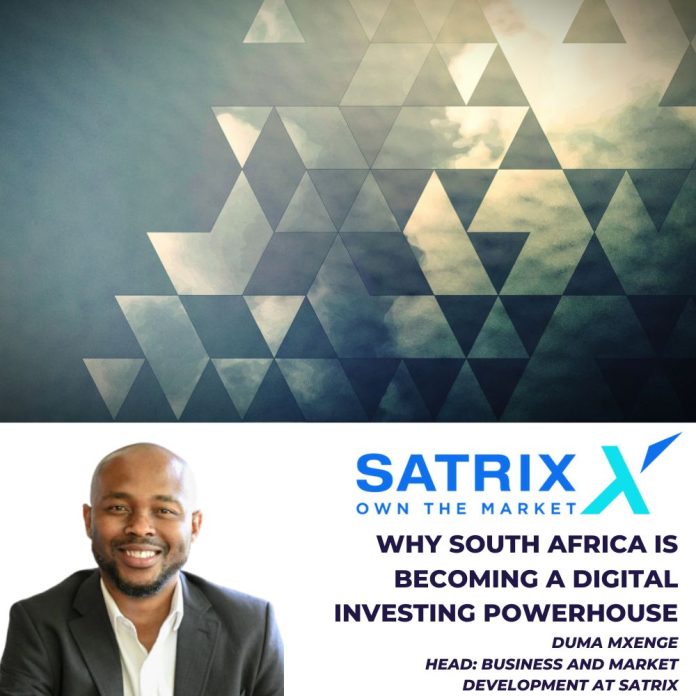South Africa is rapidly emerging as a digital investing leader, driven by mobile-first platforms, financial inclusion efforts, and a tech-savvy population
Digital investing in emerging markets (EM) is growing twice as fast as in developed ones – and South Africa is punching above its weight. Technology is making long-term investing accessible to more people than ever before.
It’s worth asking: how can we accelerate this momentum of digital wealth creation in South Africa?
Globally, the digital wealth market is projected to grow from US$3.3 billion in 2024 to US$8.5 billion by 2032. In South Africa, the momentum is tangible. We score 65/100 on Amundi’s Digital Investor Global Index (DIGI) – above the global average – reflecting strong usage, portfolio weight, advice habits, and peer advocacy.
We’re entering an era where investing is no longer the preserve of the elite, but a path open to anyone with a smartphone and a plan. Platforms like SatrixNOW have helped make this possible by lowering costs and barriers to entry.

Emerging Markets Are Leading the Charge
Emerging markets are at the forefront of this shift. In Southeast Asia, the digital investment market is on track to surpass US$44 billion by 2025, fuelled by a rising middle class and near-universal smartphone adoption. Eastern Europe is following suit, with forecasts showing this market could exceed €412 billion by 2029.
Africa’s story is particularly compelling. Nearly half of the world’s mobile banking accounts are based on the continent. From Kenya’s M-Pesa to South Africa’s fintech evolution, mobile-first investors are bypassing legacy systems. A young, tech-savvy population, falling data costs, and affordable smartphones are accelerating uptake. Even global giants like BlackRock and Amundi are backing EM platforms that blend ESG intelligence with digital-first experiences. Emerging markets aren’t catching up – they’re shaping the next wave of investing.
Why Digital Wealth Matters in South Africa
Digital platforms have transformed access to financial tools. What once required paperwork and high fees is now available at the tap of a screen. Neobrokers, robo-advisers, digital banks and even telcos are entering the space, all to make it easier, cheaper, and more personalised to grow your money.
For South Africa, this isn’t just convenient – it’s critical. Financial literacy gaps are wide, informal employment is high, and access to traditional financial tools remains unequal. The national savings rate has hovered between 0.13% and 0.5% – far below Brazil (16.9%) and India (10.8%). Digital platforms are not a ‘nice-to-have’. They are essential infrastructure for inclusion.
South Africa’s Digital Curve
The growth of digital investing here is measurable and strong. Statista projects South Africa’s digital investment market will reach US$8.49 billion in 2025. Neobrokers are expected to drive most of this, signalling demand for low-cost, intuitive platforms.
This evolution didn’t happen overnight. It began with foundational shifts, such as the introduction of the first exchange traded fund (ETF) by pioneer Satrix in 2000, which paved the way to democratise access to the broader market. The curve steepened significantly with the arrival of zero-minimum, fractional-share platforms in 2014, which completely dismantled the high barriers to entry that kept many first-time investors on the sidelines.
Today, as the market enters maturity, traditional financial institutions are no longer watching from the sidelines. Many are partnering with or launching digital platforms to reach a new generation of investors.
Education Is Key
Access is only half the equation – understanding how to use these tools is the other. Only 51% of South Africans are considered financially literate, creating a gap between access and effective participation. That’s why Satrix supports initiatives like Money School, a free virtual learning platform for young people, and Digify Africa, which delivers financial lessons via WhatsApp in local languages.
We are also collaborating with partners like Digify to host roundtable discussions on how digital tools can bridge the literacy gap and empower first-time investors.
Policy is catching up too. The FSCA’s Draft Conduct Standard for Financial Education is a bold step towards scalable, inclusive learning.
What’s Next?
The digital wealth movement can’t be driven by platforms alone. Regulators must enable innovation. Employers need to support financial well-being. Advisers should expand their reach. Communities must share knowledge. And investors need to lead by example.
At Satrix, our goal is simple: to help every South African own a piece of the market. So, let’s measure. Let’s educate. And most importantly – let’s invest and let’s own the market.
This article was first published here on the Satrix website.
Disclaimer
Satrix Investments (Pty) Ltd is an approved FSP in terms of the Financial Advisory and Intermediary Services Act (FAIS). The information does not constitute advice as contemplated in FAIS. Use or rely on this information at your own risk. Consult your Financial Adviser before making an investment decision.
Satrix Managers (RF) (Pty) Ltd (Satrix) is a registered and approved Manager in Collective Investment Schemes in Securities and an authorised financial services provider in terms of the FAIS.
While every effort has been made to ensure the reasonableness and accuracy of the information contained in this document (“the information”), the FSPs, their shareholders, subsidiaries, clients, agents, officers and employees do not make any representations or warranties regarding the accuracy or suitability of the information and shall not be held responsible and disclaim all liability for any loss, liability and damage whatsoever suffered as a result of or which may be attributable, directly or indirectly, to any use of or reliance upon the information.



